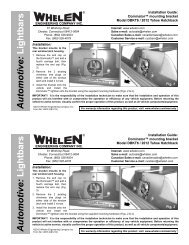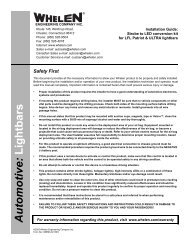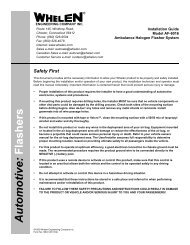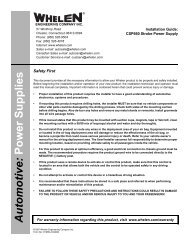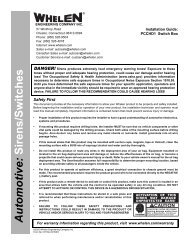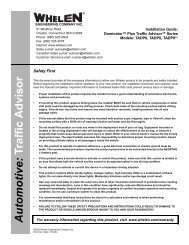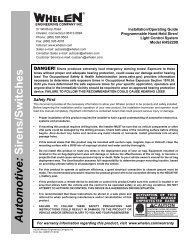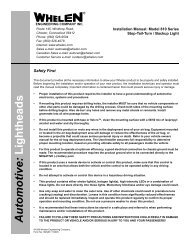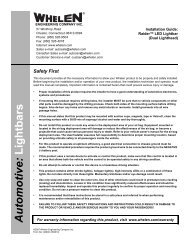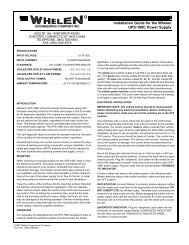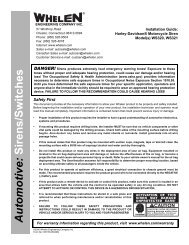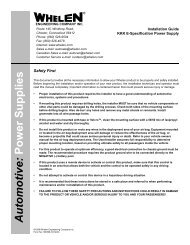Alpha 22M Siren - Busch & Associates
Alpha 22M Siren - Busch & Associates
Alpha 22M Siren - Busch & Associates
Create successful ePaper yourself
Turn your PDF publications into a flip-book with our unique Google optimized e-Paper software.
The following diagrams provides basic switching information for installations that will not use <strong>Alpha</strong> switches.<br />
Mechanical <strong>Siren</strong> Mode -<br />
WHT/BRN (Mechanical <strong>Siren</strong> Wail)<br />
To Aux. Power (RED)<br />
WHT/GRN (Air Horn)*<br />
Connection shown for<br />
reference purposes only!<br />
WHT/RED (Mechanical <strong>Siren</strong> Manual)<br />
To Aux. Power (RED)<br />
WHT/GRN (to Amp)<br />
WHT/YEL (Air Horn)<br />
To Aux. Power (RED)<br />
To Switch Wiper<br />
Switch<br />
(SPDT)<br />
Power Call Mode -<br />
Horn<br />
Relay<br />
CUT<br />
WIRE<br />
Vehicle<br />
Horn<br />
WHT/BRN (Whoop)<br />
To Aux. Power (RED)<br />
WHT/GRN (Override)*<br />
WHT/RED (Warble)<br />
WHT/ORG (Wail)<br />
To Aux. Power (RED)<br />
WHT/YEL (Air Horn)<br />
To Aux. Power (RED)<br />
Connecting to your Horn Relay:<br />
1. Locate your vehicle’s horn relay. Now locate the wire that connects<br />
the vehicle horn to the horn relay and cut this wire.<br />
2. Extend each end of the cut wire (using a minimum 16 gauge wire) to<br />
a user supplied SPDT horn transfer switch.<br />
3. Connect the wire coming from the horn relay to the switch “wiper”<br />
(see reference diagram above).<br />
4. Connect the wire coming from the horn to one side of the switch<br />
(see reference diagram above).<br />
5. Connect the WHITE/GREEN* wire from the 16 position connector to<br />
the other side of the switch as shown.<br />
* The wiring diagrams assume the vehicle uses a positive<br />
activated horn ring signal. If this signal is ground<br />
activated, use the solid GREEN wire instead of the WHITE/<br />
GREEN wire<br />
The installation of your ALPHA<strong>22M</strong> series siren amplifier will be<br />
complete after the fuse block wire is connected to the POSITIVE (+)<br />
terminal of the battery. After this connection has been made, visually<br />
inspect the fuse on top of the amplifier and at the battery. If either of<br />
these fuses is blown, carefully inspect all of the circuit wires and make<br />
sure they are wired correctly. Replace the blown fuses with ones of an<br />
identical amp rating as the original. If these fuses blow after installation<br />
or activation, contact Whelen Engineering Technical Support.<br />
Input Voltage<br />
Input Current (Off)<br />
Input Current (Stand-By)<br />
Input Current (<strong>Siren</strong>)<br />
Output Voltage<br />
Speaker<br />
Output Power@15VDC<br />
Control Voltage<br />
Control Current<br />
H/R Voltage<br />
H/R Current<br />
Operating Temp.<br />
Operating Humidity<br />
Specifications<br />
-<br />
-<br />
-<br />
-<br />
-<br />
-<br />
-<br />
-<br />
-<br />
-<br />
-<br />
-<br />
-<br />
-<br />
13.5 VDC ±20%<br />
0mA<br />
90mA<br />
16 AMPS (w/200W <strong>Siren</strong>)<br />
18 AMPS (w/100W <strong>Siren</strong>)<br />
34 V RMS (MAX.)<br />
11 ohm (2 100 Watt MAX.)<br />
200 WATTS (MAX.)<br />
Input Voltage<br />
125mA (TYP.)<br />
Input Voltage or Ground<br />
15mA (TYP.)<br />
-30° C. to +60° C.<br />
95% Non Condensing<br />
ACTIVATION OF THIS<br />
SIREN MAY DAMAGE<br />
UNPROTECTED EARS!<br />
Wear<br />
Protection!<br />
CAUTION<br />
Loud siren noise can cause<br />
hearing damage and/or loss.<br />
Refer to OSHA Section 1910.95 prior<br />
to putting ANY siren into service!<br />
Page 7



